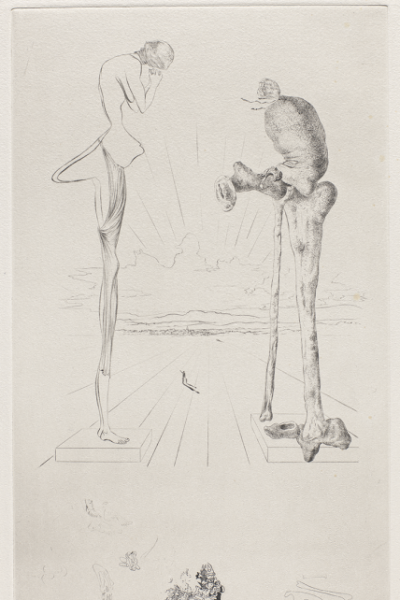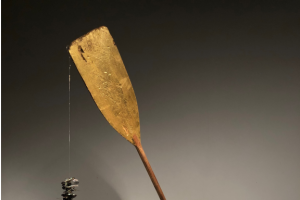
W&L’s Staniar Gallery Presents Rare Salvador Dalí Collection ‘Salvador Dalí: Les Chants de Maldoror’ features original etchings from the surrealist and will run from Jan. 11 through Feb. 8.
Washington and Lee University’s Staniar Gallery is pleased to present “Salvador Dalí: Les Chants de Maldoror,” in partnership with the Virginia Museum of Fine Arts. The exhibit will be on view in the Lenfest Center for the Arts from Jan. 11 through Feb. 8, and a lecture and reception are slated for Jan. 30 at 5:30 p.m.
The exhibition and opening reception events are free and open to the public.
Between 1933 and 1934, Dalí created 44 illustrations for Albert Skira’s republication of “Les Chants de Maldoror,” a fantastical 1869 text written by Isidore Ducasse, better known by his pen name, the Comte de Lautréamont. The French surrealists championed the text’s rebellious spirit and bizarre prose, saving it from obscurity, and Lautréamont became a touchstone for surrealism throughout the 20th and 21st centuries.
The Virginia Museum of Fine Arts (VMFA) recently purchased Dali’s 44 etchings under the guidance of Michael Taylor, chief curator and deputy director of art and education. Taylor is co-curating the Staniar Gallery exhibit with Elliott King, associate professor of art history at W&L and fellow surrealist scholar. The exhibition is a celebration of surrealism, coinciding with the centennial anniversary of the movement’s founding marked by the 1924 publication of “The Surrealist Manifesto,” written by the French poet André Breton.
“This exhibition has been an ideal opportunity for me to combine my teaching and research,” King said. “As an art historian specializing in surrealism, I’ve taught a lecture and seminar class before on the subject, but this term’s seminar has been unique in that it has leaned into my expertise in Salvador Dalí’s art and writing.”
The exhibit presents a unique opportunity for the students in King’s seminar to learn about the curation process and dive into the creations and legacy of the surrealist movement. The students will be writing the wall texts that will accompany the works in the exhibition not only during its tenure in the Staniar Gallery, but also when it is on view at Piedmont Arts in Martinsville, Virginia, and the VMFA in Richmond.
For Greer Henderson ’25, learning about Dalí’s “Les Chants de Maldorer” illustrations has been a useful framework for understanding Dalí and, more broadly, surrealism itself. “There’s so much more to it than most people realize,” she said.
Cole Gershkovich ’24 also finds that this set of etchings offers important insight into Dalí’s art and the early inspirations for the surrealist movement. “The exhibition is a unique opportunity for the Staniar Gallery to showcase work from an artist everyone knows — or thinks they know,” he said.
Selections from King’s own collection of rare surrealist books and ephemera will also be on display alongside Dalí’s etchings, lending a unique touch to the exhibition while amplifying King’s expertise on the subject matter.
“Most of the time I’m the only one who really sees these items, so I am looking forward to having some of them in the same space as world-class artworks from the VMFA, telling the story of Dalí and Lautréamont and hopefully raising some new ideas for visitors about surrealism’s past and present,” he said.
For King, one of the highlights of co-curating the exhibit has been thinking about Lautréamont’s influence on surrealism, and how and why he so regularly resurfaces within the movement’s history.
“Prior to this exhibition, I knew highlights of the many references to Lautréamont in surrealism, but I’ve become almost obsessive now realizing how wholly pervasive his influence was,” he said.
Even before Breton’s “Manifesto of Surrealism,” early avant-garde writers and artists were inspired by Lautréamont, and his spirit of revolt can be detected throughout various cultural and artistic movements of the 20th century. In agreeing to create a suite of prints illustrating “Les Chants de Maldoror,” Dalí contributed to an already vibrant discourse connecting Lautréamont and the surrealists, but the historical significance of Dalí’s prints cannot be overstated.
Only 100 copies of the illustrations were printed, and when the etchings were reproduced to accompany Skira’s 1934 edition of Lautréamont’s text, they were printed using a photomechanical process called photogravure. The photogravure versions are typically what are shown in museums’ collections — including the collection at The Museum of Modern Art in New York — but the Staniar Gallery will be exhibiting the original etchings that Dalí made in the workshop of Roger Lacourière, as the set of etchings the VMFA acquired were owned by Lacourière himself. Furthermore, while 42 etchings were included with the text, Dalí created 44 illustrations in total, and all 44 will be on display at the Staniar Gallery, with Dalí’s hand-drawn doodles (his “remarques”) visible on the printing plates.
“I really want to underscore for visitors that this truly is a very rare and remarkable set of images,” King said. “It’s a special opportunity to see a complete set of 44 images, all etchings, and with Dalí’s remarques.”
This exhibition was organized by the Virginia Museum of Fine Arts.
For more information about the 2023-24 exhibition and programming schedule, visit Staniar Gallery’s website.
Staniar Gallery is located on the second floor of Wilson Hall, in Washington and Lee University’s Lenfest Center for the Arts. When the campus is open to the public, gallery hours are Monday through Friday, 9 a.m. to 5 p.m. For more information, please call 540-458-8861.
 Salvador Dalí (Spanish, 1904–1989), Les Chants de Maldoror, 1934. Etching with drypoint in black ink on Vélin d’Arches paper with full margins and remarques. Virginia Museum of Fine Arts, Arthur and Margaret Glasgow Endowment, 2018.421.1–44
Salvador Dalí (Spanish, 1904–1989), Les Chants de Maldoror, 1934. Etching with drypoint in black ink on Vélin d’Arches paper with full margins and remarques. Virginia Museum of Fine Arts, Arthur and Margaret Glasgow Endowment, 2018.421.1–44

You must be logged in to post a comment.